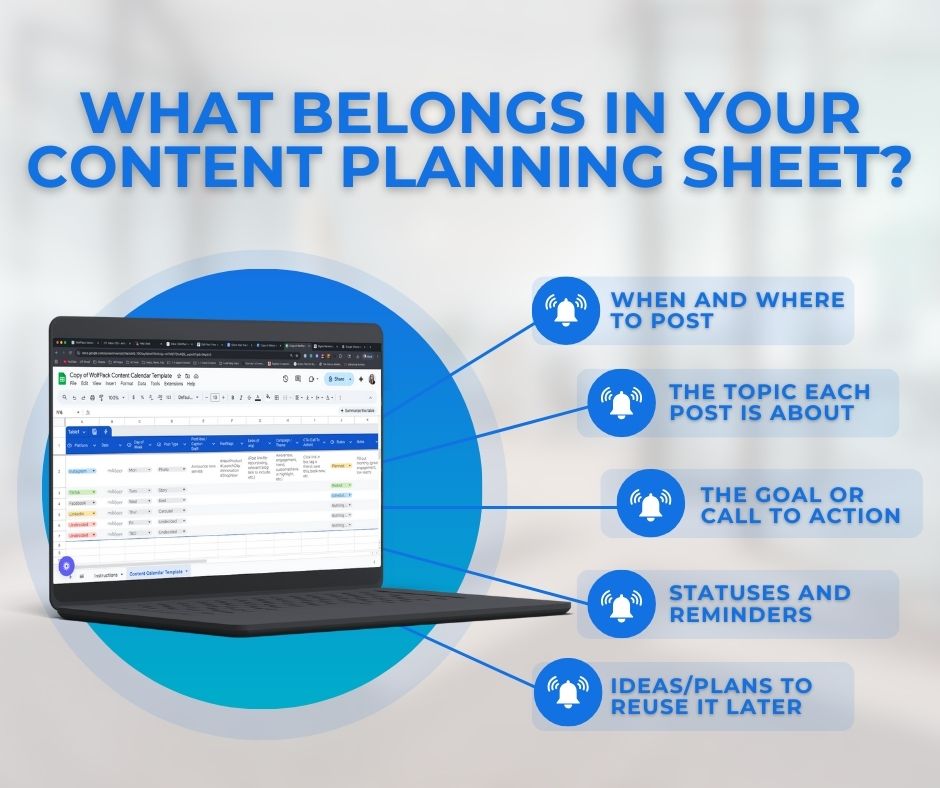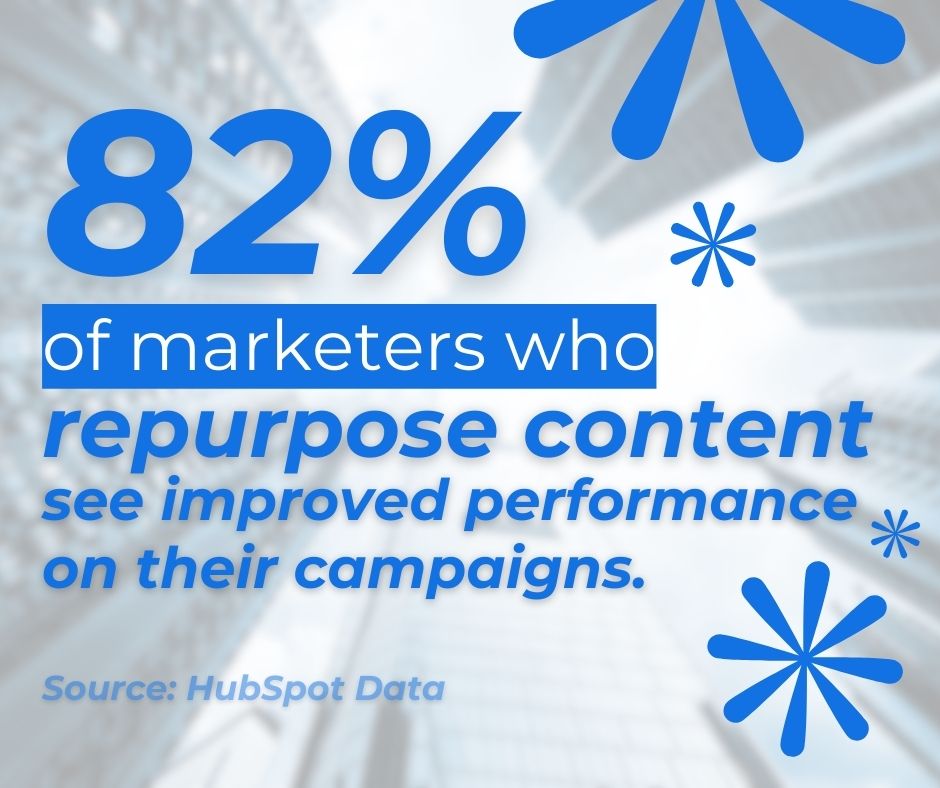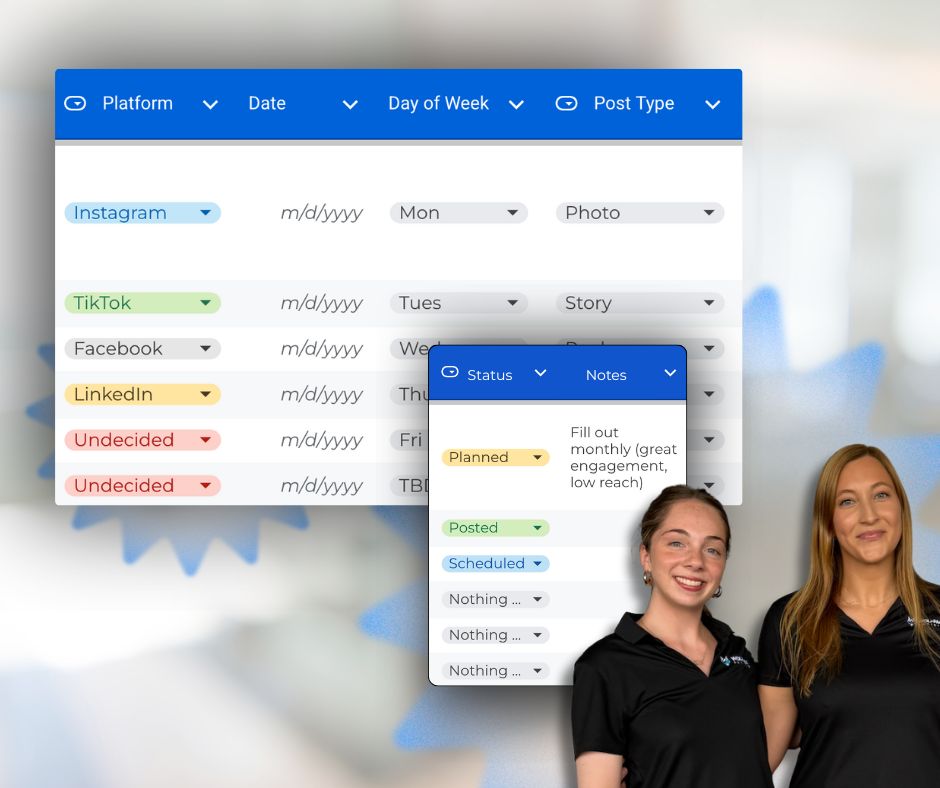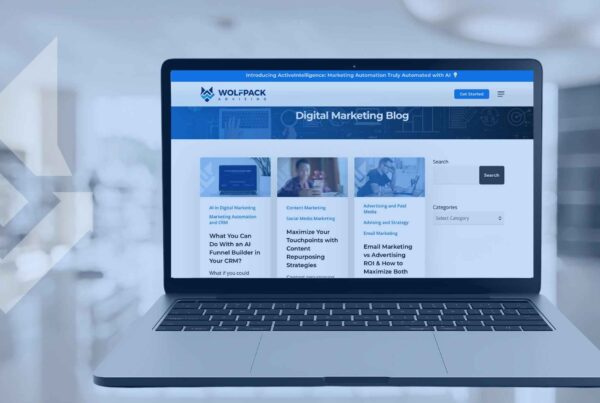Last updated on December 12th, 2025 at 03:43 pm
If you’re struggling to stay consistent with content, you’re definitely not alone…but that doesn’t mean you need to settle. The solution is as simple as a planning system, like a Google Sheets calendar template.
Most business owners have plenty of ideas, but when those ideas live in scattered notes, open tabs, or their memory, they rarely turn into posts that perform well. That’s why content often feels stressful, inconsistent, or last-minute, even when you’re trying to stay organized.
A simple, repeatable system, whether you’re posting blogs, social media, videos, or emails, helps you plan ahead, reduce your workload, and make your content more cohesive across channels.
This post will walk you through some of the best templates available, how to use yours, and how to stay consistent without burning out.
Contents
How a Content Calendar Changes Everything
A content calendar is more than just a place to drop ideas (although it’s great for that, too).
Around 64% of the most profitable marketers always keep a content calendar, compared to only 14% of the least profitable.
That kind of gap makes one thing clear: consistency starts with a system. And the simpler your system is, the more likely you are to use it.
Your content calendar is a way to make your content easier to manage, easier to execute, and easier to keep consistent.
When you’re trying to juggle blog posts, Instagram captions, email campaigns, or video ideas without a calendar, things fall through the cracks. A good planner gives you a clear snapshot of what’s coming, what’s missing, and what’s possible, all in one place.
With a reliable content calendar that you keep updated, you can…
- Plan ahead instead of reacting week to week (but not so far ahead that topics get stale)
- Keep your message aligned across every platform
- Track what content has been created, scheduled, or published
- Reuse high-performing content more strategically
- Reduce stress by making fewer day-to-day decisions
Whether you’re managing content on your own or with a team, a calendar turns scattered ideas into a structured plan.

Why a Google Sheet Works Like a Charm
There are plenty of tools that claim to fix your content strategy, but most of them just add more steps, more logins, or more complexity you don’t need.
For most businesses, Google Sheets is still the easiest and most sustainable way to stay on track.
1. It’s free and already in your workflow
If you use Gmail or Google Drive, you already have access to Google Sheets. No subscriptions, learning curves, or new apps to manage.
2. It’s flexible
You can customize the calendar to match your process. Add columns, create filters, adjust formats, or color-code by platform.
3. It’s collaborative
You can share the sheet with your team, virtual assistant, or marketing partner and update it together in real time.
4. It’s proven
According to the Content Marketing Institute, most successful marketers use a content calendar. It remains one of the most common and effective planning tools used by small businesses and large brands alike.
What Needs to Show Up in Your Content Calendar
Here are the core fields you should include in your calendar:
- Date: When the content should go live
- Platform: Blog, Instagram, Email, YouTube, Facebook, etc.
- Topic or Title: A short summary of the content
- Format: Post, carousel, video, Reel, newsletter, etc.
- CTA or Goal: What action do you want the audience to take
- Status: Idea, In Progress, Scheduled, or Published
- Draft Link: Where the content is being created or stored
You can also include optional columns like…
- Assigned To: Who’s responsible for the post
- Repurposing Notes: Where else could this content be used
- Performance Notes: Space to reflect on how the post performed
If you’re just getting started, keep it simple. You can always expand as your system evolves.
How to Plan a Month of Content at a Time
If you’re tired of scrambling every week, monthly batch planning can save time and stress. Here’s how to do it in five easy steps using your calendar:
1. Note any important dates
Start by filling in any promotions, holidays, or business events you want to feature. These become your anchor posts.
2. Add recurring content
This could be weekly blog posts, “tip Tuesday” Reels, or monthly newsletters. Drop these into the calendar first.
3. Fill in supporting topics
Think about FAQs, service spotlights, testimonials, or behind-the-scenes posts. These help balance out your content mix.
4. Repurpose what already exists
Look back at old blog posts, newsletters, or videos. Can they be reused or reimagined? Note those in your calendar.
5. Review and adjust
Look across the calendar for gaps. Make sure you’re not ignoring any platform. If you’re heavy on blog content but light on social, even it out.
This process takes about 60 to 90 minutes per month, but can save hours each week once you’re up and running.

How to Repurpose Content Using Your Calendar
Repurposing is one of the most overlooked strategies for saving time and giving each piece of content more reach. A content calendar helps you plan this out in advance and track what’s already been reused.
Example:
- Blog post: “5 Signs You Need a Plumbing Inspection”
- Instagram carousel: 3 topics from the blog
- Email: A quick summary + link to the full post
- Short video: 1 topic explained in 30 seconds
You can add a “Repurpose” or “Crosspost” column in your sheet or make quick notes under each original post. This prevents overlap, helps you reach new audiences, and increases the value of every piece you publish.
One of HubSpot’s recent State of Marketing reports showed that 82% of marketers who repurpose content see improved campaign performance.
How to Make Your Calendar Easy to Stick With
Tools only work if you use them. Here are five tips to keep your calendar useful over time:
1. Keep it simple
Don’t overwhelm yourself with 12 columns. Start with the basics and add more only when they serve a real purpose.
2. Block time weekly or monthly
Even 30 minutes a week to review and update the calendar helps you stay ahead.
3. Color-code by channel or status
Use light color fills to mark different content types or progress stages. This makes the calendar easier to scan at a glance.
4. Make it visible
Pin it in your bookmarks bar. Create a shortcut on your desktop. Keep it easy to find so you’re more likely to use it.
5. Review what’s working
Set aside time once a month to look back. What content got the most engagement? What didn’t land? Use this info to shape future plans.
Grab WolfPack’s Free Google Sheets Calendar Template
We’ve created a free, editable Google Sheets calendar template that’s got everything you need to plan out next week’s content. Duplicate it in multiple tabs to plan further ahead!
It’s designed for anyone who wants to simplify content planning across multiple channels.
Inside, you’ll get:
- A quick intro page with some tips for using our template
- Pre-labeled columns and intuitive drop-downs
- A filled-out example row for clarity or inspiration
- A field for notes to help keep track of repurposing and performance
👉 Click here to copy the free template and start planning your next month of content in minutes.

Related Questions
How do I make a content calendar in Google Sheets?
Start with a blank spreadsheet. Add columns for publish date, topic, platform, format, and status. Use one row per post and update it weekly or monthly.
What should be in a content calendar?
The most helpful calendars include date, platform, topic, format, CTA, status, and a link to the draft. Optional fields like repurposing or performance tracking are useful too.
Is Google Sheets good for content planning?
Yes. It’s free, easy to use, and flexible enough to support solo creators or full teams. It works especially well when paired with batch planning.
How far ahead should I plan content?
Start with two to four weeks. Monthly planning gives you more flexibility while helping you stay consistent.
How do I stay consistent with content?
Use a calendar to reduce daily decisions. Plan in batches, repurpose older content, and create systems you can maintain over time.
Final Thoughts
Most content problems come down to lack of planning, not lack of effort. Using a Google Sheets calendar template gives you a simple way to get organized, stay consistent, and reduce stress.
You’ll spend less time guessing and more time publishing content that supports your business goals. Start with the free template, tweak it to fit your workflow, and try it for one month.
The time you save will speak for itself.
Want help creating content that performs and doesn’t stress you out? That’s what we do!
Get in touch today to talk about your custom strategy.






